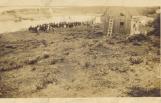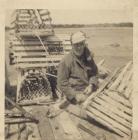1
In "Visiting the Memories of Our Past" we very soon realize how our lives have been changed. What was once a way of life for many is now a way of life for a few. With an aging population and youth of today leaving the region to begin their futures elswhere, and the problem of outmigration and high unemployment, the very essence of the communties is changing.3
The fishing industry of today is nothing like the industry of years gone by. The cod moratorium of 1992 and 1993 has changed a way of life for all residents along the Viking Trail. The cod moratorium has touched the lives of all Newfoundlanders and Labradorians in the rural communities. The use of the cod trap may never return as a way of harvesting the once plentiful Atlantic cod. The main fishery of today is the lobster fishery. Lobster traps can be seen along the Viking Trail and are usually a good indication you are getting close to a community.5
The automation of the forestry industry has also changed the way of life for many along the Great Northern Peninsula. At one time, thousands of men worked in the lumber camps during the winter. A lot of hours were spent cutting pulpwood to feed the papermill. Today, all of the forest resources are mechanically harvested and large numbers of men with bandsaws and later chainsaws are a thing of the past. The forestry industry of today has not only changed a way of life, but has also changed the very landscape which once supported it.6
A wood boom at the mouth of St. Genevieve River. High water on the river during Spring.1933
St. Genevive


